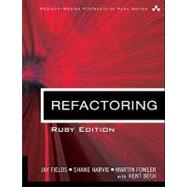
Refactoring Ruby Edition
by Fields, Jay; Harvie, Shane; Fowler, Martin; Beck, KentRent Textbook
Rent Digital
New Textbook
We're Sorry
Sold Out
Used Textbook
We're Sorry
Sold Out
How Marketplace Works:
- This item is offered by an independent seller and not shipped from our warehouse
- Item details like edition and cover design may differ from our description; see seller's comments before ordering.
- Sellers much confirm and ship within two business days; otherwise, the order will be cancelled and refunded.
- Marketplace purchases cannot be returned to eCampus.com. Contact the seller directly for inquiries; if no response within two days, contact customer service.
- Additional shipping costs apply to Marketplace purchases. Review shipping costs at checkout.
Summary
Author Biography
Jay F ields is a software developer for DRW Trading and a frequent conference presenter. Jay has a passion for discovering and maturing innovative solutions. Jay’s website is available at www.jayfields.com.
Shane Harvie has delivered software in Agile environments in the United States, India, and Australia. He works for DRW Trading in Chicago and blogs at www.shaneharvie.com.
Martin Fowler is Chief Scientist at ThoughtWorks and one of the world’s leading experts in the effective design of enterprise software. He has pioneered object-oriented development, patterns, agile methodologies, domain modeling, UML, and Extreme Programming. His books include Refactoring, Analysis Patterns, and UML Distilled. His book, Patterns of Enterprise Application Architecture, won Software Development’s Jolt Productivity Award and Javaworld.com’s best Java book award.
Table of Contents
| Refactoring, a First Example | |
| Principles in Refactoring | |
| Bad Smells in Code | |
| Building Tests | |
| Toward a Catalog of Refactorings | |
| Composing Methods | |
| Moving Features Between Objects | |
| Organizing Data | |
| Simplifying Conditional Expressions | |
| Making Method Calls Simpler | |
| Dealing with Generalization | |
| Big Refactorings | |
| Putting It All Together | |
| Table of Contents provided by Publisher. All Rights Reserved. |
An electronic version of this book is available through VitalSource.
This book is viewable on PC, Mac, iPhone, iPad, iPod Touch, and most smartphones.
By purchasing, you will be able to view this book online, as well as download it, for the chosen number of days.
Digital License
You are licensing a digital product for a set duration. Durations are set forth in the product description, with "Lifetime" typically meaning five (5) years of online access and permanent download to a supported device. All licenses are non-transferable.
More details can be found here.
A downloadable version of this book is available through the eCampus Reader or compatible Adobe readers.
Applications are available on iOS, Android, PC, Mac, and Windows Mobile platforms.
Please view the compatibility matrix prior to purchase.
